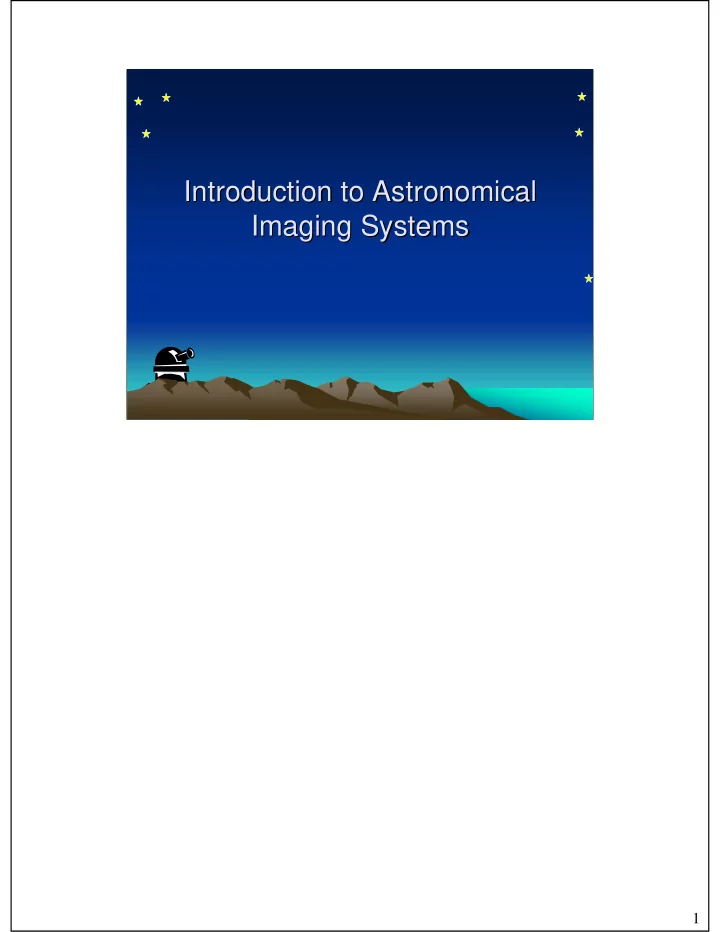

Introduction to Astronomical Introduction to Astronomical Imaging Systems Imaging Systems 1
Goal of Imaging Systems Goal of Imaging Systems • Create an “image” of a scene that may be measured to calculate some parameter (some “quantitative information) about the scene • Examples: – Diagnostic X ray – Digital Photograph – “CAT” Scan (computed tomography) – “MRI” (magnetic resonance imaging) 2
Imaging “ “Chain Chain” ” Imaging “Stages Stages” ” of Imaging Systems of Imaging Systems “ One Possible Classification: Object 1. (often one and the same!) Source 2. Collector (lens and/or mirror) 3. Sensor 4. Image Processing (computer or eye-brain) 5. Display 6. Analysis 7. 3
Optical Imaging Chain Optical Imaging Chain 1: source 5: processing 6: display 7: analysis 3: collector 2: object 4: sensor 4
Issues in Astronomical Imaging Issues in Astronomical Imaging • (Differences between astronomical and “normal” imaging) – Distances between objects and Earth – Intrinsic “brightness” of object • generally very faint ⇒ large image collectors – Type of energy emitted/absorbed/reflected by the object • wavelength regions – Motion of object • Intrinsic or Apparent 5
When you think of a clear, dark When you think of a clear, dark night sky, what do you visualize? night sky, what do you visualize? • Human visual system (HVS) is fine-tuned to focus, detect, and process (i.e., to create an “image” of) the particular wavelengths where the Sun emits most of its energy – evolutionary outcome: we see “best” in the dominant available band of wavelengths • As a result, when we look at the night sky, what we see is dominated by starlight (like the sun) – We think of stars and planets when we think of astronomy 6
Electromagnetic Spectrum Electromagnetic Spectrum Visible Light 7
Information at Different Information at Different Wavelengths – – Centaurus Centaurus A A Wavelengths X Rays (Chandra) Ultraviolet (GALEX) Visible Light Visible Light Sketch by John Herschel (Anglo-Australian Obs.) Radio (VLA) Far IR (IRAS) Near Infrared Mid Infrared (2MASS) (Spitzer Space Telescope) Decreasing Wavelength λ 8
λ Systems/Sensors for Different λ Systems/Sensors for Different • Radio Waves: Radio Telescope • Infrared Light: Telescope w/ IR Camera • Visible Light: Optical Telescope • Ultraviolet Light: Space-based Telescope • X Rays: Space-based X-Ray Telescope 9
Radio Wavelengths Radio Wavelengths • Much longer than visible light λ ≥ 1 mm • Used for TV, Radio, Radar 10
Radio Telescope Radio Telescope 100m at Green Bank, WV 305m at Arecibo, Puerto Rico Image courtesy of NRAO/AUI http://www.naic.edu/about/ao/telefact.htm 11
Radio Telescopes Radio Telescopes • Diameter of “collector” is very large (10s – 100s of meters) • Large Diameter Necessary to Obtain “Angular Resolution” – Ability to distinguish two sources that are close together (separated by a small angle) 12
Radio vs. Visible, Orion Nebula Radio vs. Visible, Orion Nebula λ ≈ 207 mm ≈ 207,000,000 nm 700 nm ≥ λ ≥ 400 nm NCSA Astronomy Digital Image Library 13
Imaging Instruments Used for Imaging Instruments Used for Previous Photos of Orion Nebula Previous Photos of Orion Nebula ) s e l i m 25m 2 2 ( m k 6 3 o t p u 4.2m Radio Telescope Array Optical Telescope Image courtesy of NRAO/AUI 14
Very Large Array = VLA Very Large Array = VLA • 27 telescopes • 25m diameter • transportable on rails • separations up to 36 km (22 miles) Image courtesy of NRAO/AUI 15
Infrared Wavelengths (IR) Infrared Wavelengths (IR) • Wavelengths λ are longer than for visible light 25 µ m ≥ λ ≥ 1 µ m • This light is absorbed by water vapor in atmosphere 16
“Thermal Infrared Thermal Infrared” ” Astronomy Astronomy “ • Conveys information about temperature – i.e., images show “heat” Courtesy of Inframetrics 17
Infrared Astronomy Infrared Astronomy • Because “thermal” infrared light is generated by heat, detector must be cooled to a lower temperature to measure the light – Uncooled detector is analogous to camera that also has an internal light source • camera itself generates a measurable signal • Cooling detector is a BIG issue in infrared astronomy 18
X- -Ray Wavelengths Ray Wavelengths X • Much shorter than visible light 0.1n m ≥ λ • X-Ray Telescope creates image of distribution of X rays in object 19
Medical X- -Ray Imaging Ray Imaging Medical X negative image Medical Imaging: 1. X Rays from source are absorbed (or scattered) by dense structures in object (e.g., bones). Much less so by muscles, ligaments, cartilage, etc. 2. Most X Rays pass through object to “expose” X-ray sensor (film or electronic) 3. After development/processing, produces shadowgram of dense structures (X Rays pass “straight through” object without “bending”) 20
Lenses for X Rays Don’ ’t Exist! t Exist! Lenses for X Rays Don (It would be very nice if they did!) ( Nonexistent Nonexistent X-Ray X-Ray X-Ray Image Lens “Light Bulb” 21
X Rays CAN Be Reflected at X Rays CAN Be Reflected at Small Angles ( Grazing Grazing Small Angles ( Incidence ) ) Incidence X-Ray “Mirror” θ X Ray at “Grazing Incidence is “Deviated” by Angle θ (which is SMALL!) 22
X Rays from Object X Rays from Object Strike One of 4 Nested Strike One of 4 Nested Mirrors… … Mirrors Incoming X Rays 23
Summary Summary • Need Imaging Systems that Can “See” the Entire Spectrum of Wavelengths (“Colors”) – Different Information is Conveyed at Different Wavelengths • X Rays and Gamma Rays • Ultraviolet (UV) Light • Visible Light • Infrared Light • Radio Waves • The Different Systems Have VERY Different Requirements 24
Recommend
More recommend